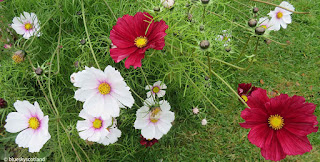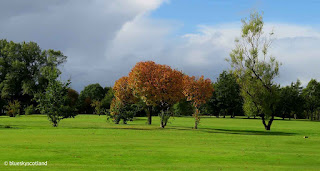ALL PHOTOS CLICK FULL SCREEN.
This was a walk instigated by my friend Anne, who fancied an urban city centre stroll for a change but I enjoyed it as well. As you can see it was a lovely day and I agreed to meet her here, which was in the heart of Partick where Partick Train Station, Subway, and Bus Hub interlink together and share a combined open space... guarded to the north by three massive gable end tenement walls. These walls used to have murals depicting sports stars from the 2014 Commonweath Games on the gables until fairly recently but now they boast more esoteric themes. Bud Neill was a popular Glasgow newspaper comic strip artist working in the 1940s/1950s/ 1960s period with an unusual and distinctive Glaswegian/American cowboy hybrid style.
Next to it is the wizard Merlin, who may or may not have had a Partick connection..... apparently. He sure did get around the UK that guy.
The third mural is a mixture of all the different wildlife you can see in Partick. Incidentally, Partick is an old school densely populated area of four storey tenements, long busy shopping streets, and heavy 24/7 traffic thundering past but it does have the River Clyde and River Kelvin running through it, Kelvingrove Park right beside it, and several other smaller green spaces within it so I have seen most if not all of the wildlife depicted here in this area.

Drawn examples of wildlife along with real ones. Local pigeons having selected this south facing ledge as a suntrap to warm up on. Good mural artists can earn a decent living with commissions like these and many do it professionally now, travelling the world to create large examples of their artwork in other cities. Glasgow has a growing reputation in this field now as it can't compete with neighbouring Edinburgh for extinct volcanoes, cobbled winding streets, viable working castles on lofty mounds, or still intact medieval history tours. Glasgow does have fine architecture of its own though, many distinctive public buildings and world class museums and universities. Back in the days when bricks and mortar buildings used to matter more it also had/has the largest UK shopping city centre district outside of London. Not so much of a boast nowadays mind you when armchair buyers who never need to leave the comfort of the living room sofa can expect everything they need to arrive delivered in a box or package... at the touch of a finger tip.

Nearby mural in Purdon Street. The previous mural here had a gardening theme as well.
Local shop. fruit and veg designs.
Rather than go up Byres Road, which we both know well as a shopping street, we picked one of the quieter back streets for a change, purely because it had trees in it, giving it a more leafy European feel, especially in the dappled warm October sunshine. I think it's probably Dowanhill Street. ( I was just doing my usual here... following her, taking photos of anything interesting, nodding at the right times when spoken to, then getting left behind if I lingered too long)
What caught my attention here was these art tiles. Six in total.
They were all good in their own way but it was the last one that captivated my attention the most as it told a three dimensional story.
Depicting the surrounding neighbourhood of Partick.
I really liked the tactile element of this. So did Anne but she was also keen to visit a favourite shop she hadn't been in for a while so she was in full stride mode to get there.
Church and tenements. You can see from the next few photographs how built up Patrick is. I like it as a district but I'm also very grateful for my own childhood growing up on the very edge of a city where I could feed dairy cows one day at a farm ten minutes from my house, walk through deep woodlands and miles of fields outside my front door or be chased by gangs through half deserted housing estates... yet still have all the pleasures of a big city environment as well a short bus ride away. You can't buy that kind of freedom... even with billions.
Cottiers theatre, bar, restaurant etc. A local landmark. Only problem as a photographer is getting it all in as the spire is so tall you can't get close to the subject without chopping it in half.
Dowanhill Public School. When this school was built in the late 1800s Govan Parish stretched to cover both sides of the River Clyde including Partick, Whiteinch and Hillhead where it built many impressive public buildings still standing today which were later incorporated into a rapidly expanding Glasgow. It's only when you see the numerous schools with Govan Parish proudly engraved on them you realise how much wealth and influence it once possessed as a major industrial, engineering, and shipbuilding powerhouse in it's own right, every bit a match for upstart Glasgow as an ancient burgh yet now just a post industrial deprived shadow of its former glory, shrunk down and confined to the south bank of the river.

One of the older buildings in Byres Road, 1876, which got it's name originally from the cow byres or barns in what was then open countryside before the relentless march of Glasgow suburban districts grew up to swallow it in pavements, shops, and tenements. Partick starts off firmly in the working class territory of Dumbarton Road but as soon as you walk up Byres Road the income bracket noticeably increases in the tenement styles and in the people around you until you reach the upmarket period terraces around Great Western Road and Kelvinside. The University of Glasgow is close by so older well heeled west end trendies are joined by groups of younger students from the University, many of whom, if they decide to stay on in Glasgow, rent or buy flats in this area. Or they used to do before the recent mini budget catastrophe. We both live too far west to be trendy anythings but Anne was determined to fully enjoy the lanes shopping experience while I contented myself with photography outdoors instead.

It is an unusual area with Ashton Lane on one side of Byres Road, seen here, having several bars, a cinema, and shops with a back alley leading directly into the university and I'd imagine a large percentage of its passing clientele come from there. I do not know how footfall or business is now in this area but I'd suspect it's down after Covid 19, the ongoing cost of living crisis, and very recent economic woes. I'd deliberately suggested a Monday afternoon to come here for selfish reasons as this place was always busy with folk sitting at tables in the past and I wanted a clear run at it for photographs without anyone else in them.
Ashton Lane mural.
A well known local haunt of the smart set for many years with several different bars, restaurant and a reputation for good food and wine. Needs some TLC on the missing letters though.
A view down Ashton Lane. Semi empty of people for once.
On the other side of Byres Road from Ashton Lane is Ruthven Lane, seen above. Ashton Lane runs parallel to Byres Road and is arrow straight whereas Ruthven Lane is more maze like with a box shape lattice and quirkier specialty shops.
Ruthven Lane and Byres Road view.
A vintage clothing shop. Guess where Anne disappeared into for half an hour?
Guess where I went during this same period?
A good time was had by all.
Ruthven Lane establishments.
Ruthven Mews arcade.
Family Group. Ruthven Lane.
'The truth is out there.' Somewhere.
We then ended up passing by several residents only private gardens that you needed a key to access.....
and a nice church....
Section of church above the double doors....
which brought us out at Grosvenor Terrace...
And the Botanic Gardens. An enjoyable and varied afternoon walk.

























































